Intercultural Science-Art Project ‘Magritte Meets Science’
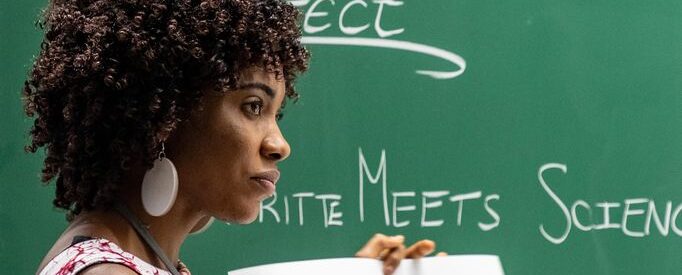
The Idea
Once the 200 Young Researchers who would participate in the 7th Heidelberg Laureate Forum (HLF) were already chosen, they were all invited to participate to an Intercultural Science-Art Project entitled ‘Magritte Meets Science’, in which they would have to create their own artworks inspired by their scientific research and the art by René Magritte.
The original goal of this project was to create awareness in society about the work of early-career researchers in academia. It is an unquestionable fact that PhD theses—even though the grand culmination of years of hard work and research—are usually not read by anyone but the candidates, their advisors and the committee. For enjoying such a read usually requires a basic understanding of the theory that underlies these results or working at least on similar topics. Either way, it is a small circle of scientists who have the privilege of fulfilling these requirements and people who do not work on academia can barely get an introductory notion of the content of the thesis. It doesn’t help this goal either that particularly in the presumably abstract fields of Mathematics and Computer Science there are many prejudgments and misconceptions about their understandability and applicability to the real world.
So it seemed like a natural idea to create a visual version of the thesis for the general public, with which they could have a more concrete concept of what the researchers actually do and what the motivation behind their work is. Innovation and creativity are the key character traits for this activity since the participants were asked to express their research in an artistic fashion. Art is an interesting tool for the purpose of breaking the gap between science and society since it gives space to emotions and feelings, which again creates a stronger bond between the scientific artist and the observer. The whole internal process of developing an idea would help the young researchers in their own work as well, since they had to ask themselves key questions about it, like “How can I explain my research comprehensibly?“ We frequently do not ask these questions, but they certainly help us to better understand what we are doing and what the goal of our work is.
A further element of the project was the intercultural focus. Keeping in mind that young researchers from all around the world meet at the HLF, it was a unique opportunity to see how people from different cultures interpret the task in their own way and how their cultural background, their country and language influence their way of working. To highlight this, they were also asked to write the titles of their artworks in their own language. This way all participants would get in touch with different languages and cultures and would create stronger bonds with people from all around the globe.
René Magritte
René Magritte, a Belgian artist from the 20th century, is considered to be one of the most important representatives of surrealism. Surrealists address unconsciousness and dreams and philosophical ideas behind these worlds in an incredibly realistic way.
In many cases, Magritte’s works can be given a mathematical interpretation. A good example is Le fils de l’homme, in which we can see a man with a bowler hat—one of Magritte’s key figures—whose face is covered by an apple. Magritte himself explained that the idea behind this work was to describe the human desire to see beyond what can be seen. The problem is that, once we see the face behind the apple, we will want to know what can be found behind the face. This is precisely the spirit of a mathematician or a computer scientist: Every obtained result gives rise to new questions and new ideas. There will never be a last theorem. Behind every theorem, we can find another one.
However, Magritte not only addresses perception, but also other ideas important to mathematics, like language. In this context, he discusses philosophical thoughts in a series of paintings in which we can see everyday objects with different labels. The combination of both, the objects and their labels, are always confusing, puzzling and irritating for the observer. The reason for this is that they initially seem to be contradictory. They challenge our intuition, our experience. However, there is always a clear idea behind this. The most famous one, La Trahison des Images, shows a pipe together with the text Ceci n’est pas une pipe.—This is not a pipe.
With this work, Magritte discusses the difference between an object in the real world, its denomination and its visual representation. Magritte asks what reality actually is and how we can describe our reality with language and images. He concludes that there are many limitations in language to represent reality.
Contrary to initial belief, mathematics possesses such limitations as well. There are many paradoxes and counterintuitive results in mathematics and in this context, we may also wonder what kind of limitations mathematics possesses to faithfully describe our world.
The Outcome
Ten Young Researchers from the 7th HLF participated in the project, where it is interesting to mention that two of them only joined the group during the HLF. They spontaneously had amazing ideas, so that we helped them create their last-minute artwork in Heidelberg.
When analyzing the outcome and comparing the different approaches the young researchers took in this project, it was nice to see that they all had a particular personal understanding of the idea and interpreted it in various ways. Some artworks show researcher‘s work straightforwardly and in an impressively clear way so that you do not even need to talk to them to understand the motivation behind their research. Others found ways of representing counterintuitive results related to their work, which is particularly amazing and honors Magritte‘s spirit as well. Then others have a strong visual component, where the colors and forms depicted tell us a story about the research. Finally, some artworks are real data sets from the research they do, which is really cool as well, since it means that the art was already there the whole time. However, the combination of all of them together is probably the most enriching experience, where we can see those different approaches and the various cultural backgrounds and languages combined with the whole idea.
Discussions
During the 7th HLF we had several discussions and conversations with the young researchers about this project. Here I would like to share some thoughts we elaborated and of which I think it is fundamental to have them written on paper. They show the innovative spirit, creative minds and commitment of these young researchers. The underlying question was whether scientific art is important.
Dragana Radojicic (Serbia) pointed out that one important aspect of intertwining mathematics with arts is that it is a way to make mathematics more visible to the non-scientific community due to the strong bond between arts and human emotions. This way people can get in touch with science in a more natural way. By reaching people‘s hearts and focusing on their critical thinking at the same time, we create a strong bond between apparently unconnected elements of human nature.
Aung Zaw Myint (Myanmar) made a very clever observation when he said that the thinking process during the creation of his artwork was very similar to the one he uses on an everyday basis in his research. You ask questions like “How can I solve this?“ or “Is this really consistent?“ After all, in both cases, we are talking about a creative instance which may even need a moment of inspiration and a carefully approached and well-thought rational instance. This connection between arts and science can be used to demystify the work of a scientist.
Lateef Olakunle Jolaoso (Nigeria) shared this opinion, by concluding that science and art are actually the same thing. They both take our reality—our real world—and interpret it by creating an abstraction of it. While one is heavily focused on objective preciseness and a clear and uniformly accepted scientific method, the other one is a rather subjective, emotional interpretation of the same affairs. The interesting thing about this is that this means we can make science more attractive to more people since it implies that scientists are nothing more than creative artists who just happen to use their own, particular tools and methods. But then, which artist doesn’t?
Danilo Afonso (Brazil) commented on the misconception that Mathematics and Computer Sciences are described as really abstract fields, whereas arts are considered to be quite visual. He pointed out that arts can be really abstract as well, whereas science is heavily inspired by the real world we live in. So this leads to the mistake of thinking that they both work in opposite directions. However, he states that both—arts and science—have one common motivation: the search for beauty and harmony. We can find an example of such beauty in Danilo‘s own research: the concept of strong and weak solutions to a differential equation. The counterintuitive nature of these theorems, which guarantee that you can find solutions to a problem by forgetting what you are looking for and going for something else, is what makes them so beautiful. Just like the baffling situations Magritte’s work makes us go through, this is the seductive part of this theory.
Jimoh Abdulganiyu (Nigeria) also explained here a concrete motivation of his artwork, in which we can see what seems to be an X-Ray, but with the additional label “This is not an X-Ray. It‘s pixels.“ He explained that the message he tries to convey is that people are not sufficiently aware of the omnipresence of science, in this case, Computer Science. By pointing out the fact that a doctor isn’t actually looking at an X-Ray but rather at pixels, he shows that people take science for granted and are not actually aware of the work and development that make such devices even possible. Of course, the artwork itself and the idea behind it is very magrittesque.
One further connection between these two fields the young researchers discovered is that in both cases the relationship between the scientist/artist and user/observer is very similar. The first presents a creation of his own, while the latter uses, interacts and interprets it. Both, the scientists and the artists have a very clear intention for their creation, but it is up to the user and the observer to decide what to do with it. Of course, the more interpretations a creation can be given and the more applications it has, the more valuable this creation will be for society.
On a final note, both—science and arts—have one thing in common. If not corrupted, they are egalitarian, democratic and peaceful pillars of society and its development. They both represent what humanity should be striving for.
The Future Work
The young researchers had very interesting ideas and the conversations we held were truly enriching. It was also easy to see that they were really enthusiastic about the project and the idea behind it, so it immediately became clear that we would try to do some further work in this context. They all agreed that since the benefits of doing scientific art are varied and clear, we should discuss further actions. Since they all did not know about scientific art until now, the conclusion was that promotion is fundamental, both, on an academic and on a social level. This may include scientific publications and participation in interdisciplinary conferences, but also art exhibitions and promoting videos on social media.
Acknowledgment
Here I would like to thank the organizers of HLF for supporting this initiative as an additional activity for this year’s young researchers. Of course, thanks to the young researchers! You are the heart of this small project by putting a lot of effort into this. The conversations we held were really encouraging, deep and insightful. You rock!


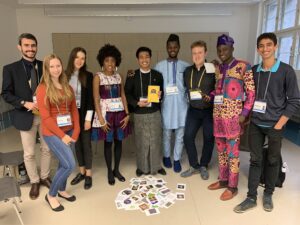

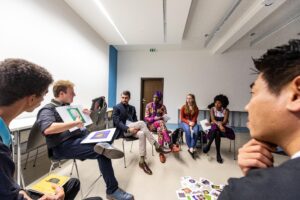
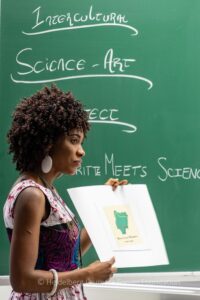
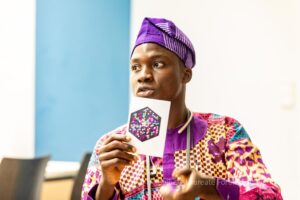
Beautiful article!
You write: Ten Young Researchers. But there are only nine on the photo. I guess the 10th is the one who took the picture …
Demian, wonderful article. Sorry I did not see it until now. I am writing about the art of Magritte and visual neuroscience – how his work informs us about the brain’s hierarchy in processing visual scenes. I could give a ZOOM lecture to your group about this fascinting topic if you want. Also, do you know anything about Mgritte’s level of knowledge about science in general and the neurocience of visual perception in particular?